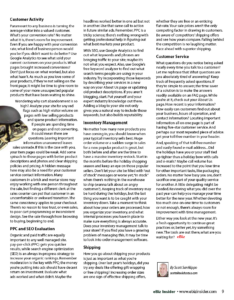
From the January / February 2010 issue of eBiz Insider magazine. Download the complete issue in PDF format by clicking here.
It’s the start of not just a new year, but a new decade. So much we’re not going to miss, so much to look forward to. Before you stride forward into 2010, spend time looking back over last year’s performance highs and lows. The weakest link may be what’s been holding you back from record sales.
Website Activity
Google Analytics is the key to unlocking the secrets of your website’s traffic. (If you’re not already wondering where your traffic is coming from, you better start). To know what needs changing, the first step is to see how well traffic converts from your homepage to product pages to the almighty checkout. Where were visitors looking, and how long did they stay on your site? How many page views did the average user have? Did your homepage have a high bounce rate? These telling stats can point out if something is potentially wrong with your site’s layout. A solid homepage captures attention and creates a call to action. A high bounce rate means you probably didn’t have anything compelling on your homepage or worse, a poor design that scared people away.
Consistent and effective navigation helps a customer find their way to what they need. If your site had high page views but not a lot of conversions, this means you were probably sending your potential customers on a virtual goose chase. Messy links, cluttered navigation, and hidden search bars frustrate customers and drive them away. Improving navigation will help get users to pages with the least hits and clickthroughs (or, the ones you’ve been burying). To get more clickthroughs, consider features like rotating banners or featured items to draw attention to products that are higher performers, and as a bonus, make it easier to change gears from season to season.
Customer Activity
Paramount to any business is turning the average visitor into a valued customer. What’s your conversion rate? No matter what it is, there’s room for improvement. Even if you are happy with your conversion rate, what kind of businessperson would you be if you didn’t want to do better? Use Google Analytics to see what sold your current customers on your products. What pages brought increased conversions?
Don’t just focus on what worked, but also what hasn’t. As much as you love some of your products, if they’re not selling on the front page, it might be time to give room to some of your more unsuspected popular products that have been waiting to shine. Wondering why cart abandonment is so high? Analyze your site for any red flags such as high visitor volume on pages with low selling products and sparse product information.
If people are spending time on pages and not converting, it could mean there are questions. Leaving important information unanswered leaves sales unmade. If this is the case with you, your item pages could be weak. Add some spinach to those pages with better product descriptions and photos and clear shipping policies and pricing. A hidden message here may also be a need for your customer service contact information.
Many customers in a brick and mortar store may enjoy working with one person throughout the sale, but finding a different clerk at the sales counter can put that customer in an uncomfortable or awkward transition. The same consistency applies to your checkout.
There’s no reason to lose trust, or even sales, to poor cart programming or inconsistent design. See the sale through from browsing to buying, beginning to end.
PPC and SEO Evaluation
Organic and paid traffic are equally important to any well managed site. pay-per-click (PPC) gets you quicker results, while search engine optimization (SEO) is an always in-progress strategy to increase your organic rankings. Remember moderation is the key with PPC; the money you’re putting into ads should have decent return on investment. Evaluate what ads worked and what didn’t. Maybe the headlines worked better in one ad but not in another. Use that same call to action in future similar ads. Remember, PPC is a tricky science; there’s nothing wrong with getting professional help in figuring out what best markets your product.
With SEO, use Google Analytics to find out what keywords and phrases are bringing traffic to your site; maybe it’s not what you expect. Also, use Google’s free keyword analyzer to find out what search terms people are using in your industry. Try incorporating those keywords by describing your services in a new way on your About Us page or updating old product descriptions. If you aren’t blogging, start. Put yourself and your expert industry knowledge out there.
Adding a blog to your site not only gives you a natural way to include those keywords, but also builds reputability.
Inventory Management
No matter how many new products you have coming in, you should know when your typical inventory sells best. Huge order volume or a sudden surge in sales for a new popular product is great, but both before and after are the time to have a massive inventory restock. Start in the months before the holiday shopping season and keep an eye on those popular sellers. Don’t let your site be filled with “out of stock” messages or worse yet, “in stock” when there’s nothing in the warehouse to ship (wanna talk about an angry customer?).
Keeping track of inventory may be hard during the holidays, but the last thing you want is to be caught with your inventory down. Take a moment to think about how your orders are processed, how you organize your inventory, and what internal processes you have in place to make sure everything is always accurate.
Does your inventory management talk to your store? If you find you have a growing problem of managing this, it may be time to look into order management software.
Shipping
How you go about shipping your products is just as important as what you’re shipping. Over last year’s holidays, did you try any deals like offering gift wrapping or free shipping? Increasing order sizes are one sign of effective shipping offers, whether they are free or an enticing flat-rate. Your sale prices aren’t the only competing factor in drawing in customers.
Be aware of competitors’ shipping offers and see how yours compare. Falling behind the competition is no laughing matter. Race ahead with superior shipping.
Customer Service
What questions do you notice being asked nearly every time you talk to a customer? Let me rephrase that. What questions are you absolutely tired of answering? Keep track of frequently asked questions. If they’re simple to answer, the time saver of a solution is to make the answers readily available on an FAQ page. While you’re at it, check out your About Us page. How recent is your information? How easily can customers find out about your business, hours of operation, and contact information? Locating important information all on one page is part of having five-star customer service. And perhaps our most repeated piece of advice: get your toll-free number in your header.
And, speaking of that toll-free number and easily found e-mail address… Did the holidays have you or your staff tied up tighter than a holiday bow with calls and e-mails? Maybe call volume has increased to the point that you lose time for other important tasks, like packaging orders. No matter how busy you are, don’t sacrifice one part of your quality service for another. A little delegating might be needed. Reviewing what you did over the past year can help you manage your time better for the new year. Whether devoting too much one-on-one time to customers or not enough, there’s always room for improvement with time management.
Either way you look at the new year, it’s a fresh opportunity to continue great practices or, better yet, try something new. The tools are out there, what are you waiting for?
 |
 |
